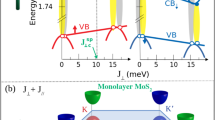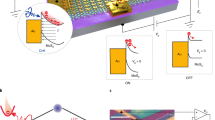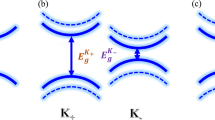Abstract
Valleytronics is an appealing alternative to conventional charge-based electronics that aims at encoding data in the valley degree of freedom, that is, the information as to which extreme of the conduction or valence band carriers are occupying. The ability to create and control valley currents in solid-state devices could therefore enable new paradigms for information processing. Transition metal dichalcogenides (TMDCs) are a promising platform for valleytronics due to the presence of two inequivalent valleys with spin–valley locking1 and a direct bandgap2,3, which allows optical initialization and readout of the valley state4,5. Recent progress on the control of interlayer excitons in these materials6,7,8 could offer an effective way to realize optoelectronic devices based on the valley degree of freedom. Here, we show the generation and transport over mesoscopic distances of valley-polarized excitons in a device based on a type-II TMDC heterostructure. Engineering of the interlayer coupling results in enhanced diffusion of valley-polarized excitons, which can be controlled and switched electrically. Furthermore, using electrostatic traps, we can increase the exciton concentration by an order of magnitude, reaching densities in the order of 1012 cm−2, opening the route to achieving a coherent quantum state of valley-polarized excitons via Bose–Einstein condensation.
This is a preview of subscription content, access via your institution
Access options
Access Nature and 54 other Nature Portfolio journals
Get Nature+, our best-value online-access subscription
$29.99 / 30 days
cancel any time
Subscribe to this journal
Receive 12 print issues and online access
$259.00 per year
only $21.58 per issue
Buy this article
- Purchase on Springer Link
- Instant access to full article PDF
Prices may be subject to local taxes which are calculated during checkout




Similar content being viewed by others
Data availability
The data that support the findings of this study are available from the corresponding author on reasonable request.
References
Xiao, D., Liu, G.-B., Feng, W., Xu, X. & Yao, W. Coupled spin and valley physics in monolayers of MoS2 and other group-VI dichalcogenides. Phys. Rev. Lett. 108, 196802 (2012).
Splendiani, A. et al. Emerging photoluminescence in monolayer MoS2. Nano Lett. 10, 1271–1275 (2010).
Mak, K. F., Lee, C., Hone, J., Shan, J. & Heinz, T. F. Atomically thin MoS2: a new direct-gap semiconductor. Phys. Rev. Lett. 105, 136805 (2010).
Zeng, H., Dai, J., Yao, W., Xiao, D. & Cui, X. Valley polarization in MoS2 monolayers by optical pumping. Nat. Nanotechnol. 7, 490–493 (2012).
Mak, K. F., He, K., Shan, J. & Heinz, T. F. Control of valley polarization in monolayer MoS2 by optical helicity. Nat. Nanotechnol. 7, 494–498 (2012).
Rivera, P. et al. Valley-polarized exciton dynamics in a 2D semiconductor heterostructure. Science 351, 688–691 (2016).
Unuchek, D. et al. Room-temperature electrical control of exciton flux in a van der Waals heterostructure. Nature 560, 340–344 (2018).
Ciarrocchi, A. et al. Polarization switching and electrical control of interlayer excitons in two-dimensional van der Waals heterostructures. Nat. Photon. 13, 131–136 (2019).
Rivera, P. et al. Observation of long-lived interlayer excitons in monolayer MoSe2–WSe2 heterostructures. Nat. Commun. 6, 6242 (2015).
Jauregui, L. A. et al. Electrical control of interlayer exciton dynamics in atomically thin heterostructures. Preprint at https://arxiv.org/abs/1812.08691 (2018).
Zhang, C. et al. Interlayer couplings, moiré patterns and 2D electronic superlattices in MoS2/WSe2 hetero-bilayers. Sci. Adv. 3, e1601459 (2017).
Yu, H., Liu, G.-B., Tang, J., Xu, X. & Yao, W. Moiré excitons: from programmable quantum emitter arrays to spin–orbit-coupled artificial lattices. Sci. Adv. 3, e1701696 (2017).
Yu, H., Liu, G.-B. & Yao, W. Brightened spin–triplet interlayer excitons and optical selection rules in van der Waals heterobilayers. 2D Mater. 5, 035021 (2018).
Jin, C. et al. Observation of moiré excitons in WSe2/WS2 heterostructure superlattices. Nature 567, 76–80 (2019).
Seyler, K. L. et al. Signatures of moiré-trapped valley excitons in MoSe2/WSe2 heterobilayers. Nature 567, 66–70 (2019).
Tran, K. et al. Evidence for moiré excitons in van der Waals heterostructures. Nature 567, 71–75 (2019).
Fang, H. et al. Strong interlayer coupling in van der Waals heterostructures built from single-layer chalcogenides. Proc. Natl Acad. Sci. USA 111, 6198–6202 (2014).
Butov, L. V., Lai, C. W., Ivanov, A. L., Gossard, A. C. & Chemla, D. S. Towards Bose–Einstein condensation of excitons in potential traps. Nature 417, 47–52 (2002).
Eisenstein, J. P. & MacDonald, A. H. Bose–Einstein condensation of excitons in bilayer electron systems. Nature 432, 691–694 (2004).
Kang, J., Tongay, S., Zhou, J., Li, J. & Wu, J. Band offsets and heterostructures of two-dimensional semiconductors. Appl. Phys. Lett. 102, 012111 (2013).
Hong, X. et al. Ultrafast charge transfer in atomically thin MoS2/WS2 heterostructures. Nat. Nanotechnol. 9, 682–686 (2014).
Hanbicki, A. T. et al. Double indirect interlayer exciton in a MoSe2/WSe2 van der Waals heterostructure. ACS Nano 12, 4719–4726 (2018).
Schaibley, J. R. et al. Valleytronics in 2D materials. Nat. Rev. Mater. 1, 16055 (2016).
Kulig, M. et al. Exciton diffusion and halo effects in monolayer semiconductors. Phys. Rev. Lett. 120, 207401 (2018).
Cadiz, F. et al. Exciton diffusion in WSe2 monolayers embedded in a van der Waals heterostructure. Appl. Phys. Lett. 112, 152106 (2018).
Laikhtman, B. & Rapaport, R. Exciton correlations in coupled quantum wells and their luminescence blue shift. Phys. Rev. B 80, 195313 (2009).
Wang, Z., Chiu, Y.-H., Honz, K., Mak, K. F. & Shan, J. Electrical tuning of interlayer exciton gases in WSe2 bilayers. Nano Lett. 18, 137–143 (2018).
Rivera, P. et al. Interlayer valley excitons in heterobilayers of transition metal dichalcogenides. Nat. Nanotechnol. 13, 1004–1015 (2018).
Grosso, G. et al. Excitonic switches operating at around 100 K. Nat. Photon. 3, 577–580 (2009).
Schneider, C. A., Rasband, W. S. & Eliceiri, K. W. NIH Image to ImageJ: 25 years of image analysis. Nat. Methods 9, 671–675 (2012).
Acknowledgements
We are grateful to J.F. Gonzalez Marin for useful discussions. We acknowledge the help of Z. Benes (EPFL Center of MicroNanoTechnology (CMI)) with electron-beam lithography. D.U., A.C., A.A. and A.K. acknowledge support by the Swiss National Science Foundation (grant no. 153298), H2020 European Research Council (ERC, grant no. 682332) and Marie Curie-Sklodowska-Curie Actions (COFUND grant no. 665667). A.K. acknowledges funding from the European Union’s Horizon H2020 Future and Emerging Technologies under grant no. 696656 (Graphene Flagship). K.W. and T.T. acknowledge support from the Elemental Strategy Initiative conducted by the MEXT, Japan and JSPS KAKENHI grants nos. JP15K21722 and JP25106006.
Author information
Authors and Affiliations
Contributions
A.K. initiated and supervised the project. A.C. fabricated the devices. D.U. performed optical measurements with assistance from A.C. A.C. and D.U. analysed the data. Z.S., A.C. and D.U. performed SHG measurements. K.W. and T.T. grew the hBN crystals. A.C., D.U., A.A. and A.K. wrote the manuscript, with input from all authors.
Corresponding author
Ethics declarations
Competing interests
The authors declare no competing interests.
Additional information
Peer review information Nature Nanotechnology thanks Min-Kyu Joo and the other, anonymous, reviewer(s) for their contribution to the peer review of this work.
Publisher’s note Springer Nature remains neutral with regard to jurisdictional claims in published maps and institutional affiliations.
Supplementary information
Supplementary Information
Supplementary Figs. 1–11 and refs. 1–5.
Rights and permissions
About this article
Cite this article
Unuchek, D., Ciarrocchi, A., Avsar, A. et al. Valley-polarized exciton currents in a van der Waals heterostructure. Nat. Nanotechnol. 14, 1104–1109 (2019). https://doi.org/10.1038/s41565-019-0559-y
Received:
Accepted:
Published:
Issue Date:
DOI: https://doi.org/10.1038/s41565-019-0559-y
This article is cited by
-
Excitonic Mott insulator in a Bose-Fermi-Hubbard system of moiré WS2/WSe2 heterobilayer
Nature Communications (2024)
-
Insight into vertical piezoelectric characteristics regulated thermal transport in van der Waals two-dimensional materials
Rare Metals (2024)
-
Recent progress of exciton transport in two-dimensional semiconductors
Nano Convergence (2023)
-
Electrical control of hybrid exciton transport in a van der Waals heterostructure
Nature Photonics (2023)
-
Harmonic to anharmonic tuning of moiré potential leading to unconventional Stark effect and giant dipolar repulsion in WS2/WSe2 heterobilayer
Nature Communications (2023)



